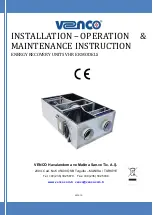
13
- Hold the welding shield in front of your face and
ignite the arc by moving the tip of the electrode
over the workpiece which has been earthed
by the earth terminal but without exerting any
pressure on it.
IMPORTANT.
Never dab the tip of the
electrode on the workpiece.
This could damage the welding set’s electronic
systems and make it difficult to ignite the arc.
- As soon as the arc has ignited, move the
electrode over the welding point, if possible at a
uniform distance from the workpiece.
- The distance between the electrode and the
workpiece depends on the electrode diameter
and the workpiece thickness.
- The electrode should be held at an angle of 20°
to 30° in the welding direction.
- Test that you have the correct current strength
using a test piece.
The final adjustment of the current strength can
be made by turning the potentiometer clockwise
or anti-clockwise to the set electrode thickness.
Changing the electrode
IMPORTANT.
The electrode holder will
become hot during welding.
- Place the electrode holder on an insulated
surface, such as a piece of wood or the like.
- Use a pair of pliers to remove the spent
electrode.
Slag removal
- Do not remove slag with the slag hammer (5)
until the weld has cooled.
- If your work is interrupted and you then
continue the welding work later, first remove the
slag and carefully clean the weld at the point you
wish to continue using the welding brush (5).
Overheating guard
The overheating guard on the welding set
protects the welding transformer from
overheating. If the overheating guard trips after
you have been using the set for a lengthy period,
the control lamp (8) will be lit. (B2)
Allow the welding set to cool down and then
reignite the arc.
6. Maintenance and care
Pull the plug before starting any work on the
machine.
- Use a damp cloth to clean the plastic parts. Do
not use cleaning products, solvents or sharp
objects.
- Clear the ventilation openings and moving parts
from deposits of dust at regular intervals using a
soft brush or paintbrush.
Important.
Store the machine in such a way that
- it cannot be started by unauthorised persons
and
- nobody can injure themselves on it.
Caution!
Do not leave the machine outdoors or in a damp
environment without protection.
7. Technical data
Mains connection 230 V ~ 50 Hz
Welding current I2 20-120 A
Duty cycle X
Welding
current
Working voltage
45%
120 A
24,8 V
60%
104 A
24,16 V
100%
80 A
23,2 V
(Heating tests were carried out in an ambient
temperature and the duty cycle at 40°C by means
of simulation.)
Idling voltage U
0
65 V
Electrode diameter mm Welding current I2
1,6 40-50 A
2 50-75 A
Summary of Contents for 120 IV
Page 2: ...2 B2 11 2 1 6 9 10 8 B3 B3 7 4 5 3 13 12 ...
Page 16: ...16 ...




































